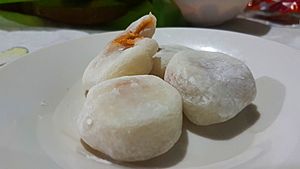Masi (food) facts for kids

Masi with peanut butter filling
|
|
| Alternative names | Peanut rice ball |
|---|---|
| Course | Dessert or snack |
| Place of origin | Philippines |
| Region or state | Liloan, Cebu |
| Serving temperature | Room temperature |
| Main ingredients | Glutinous rice, brown sugar or muscovado, chopped roasted peanuts |
| Similar dishes | Moche, Mache, Buchi, Palitaw |
Masi are yummy little glutinous rice balls from Cebu, Philippines. They have a special filling made of peanuts and a type of brown sugar called muscovado. People often enjoy Masi as a sweet treat or a snack.
Contents
What is Masi?
Masi is a traditional Filipino dessert. It is made from a special kind of rice flour. This flour comes from glutinous rice, which is also known as sticky rice. The rice is first soaked and then ground into a soft dough. This dough is then shaped into small, round balls.
How is Masi Made?
Making Masi involves a few simple steps. It starts with preparing the dough and the sweet filling.
Ingredients You Need
The main ingredients for Masi are glutinous rice and sugar. You will also need peanuts for the filling. Sometimes, people use muscovado sugar, which is a type of unrefined brown sugar. It gives the filling a rich, deep flavor.
Making the Dough and Filling
First, the glutinous rice is soaked in water. Then, it is ground into a paste called galapong. This galapong is sweetened and shaped into small balls. Inside each ball, a tasty filling is placed. This filling is usually made from roasted peanuts that are chopped and mixed with muscovado or brown sugar.
Cooking Masi
Once the Masi balls are shaped and filled, they are cooked. They can be boiled in water until they float to the top. This shows that they are ready! Sometimes, they are also steamed. Traditionally, Masi is wrapped in banana leaves when sold. This keeps them fresh and adds a nice smell.
Different Kinds of Masi
While the classic Masi has a peanut and sugar filling, people sometimes get creative! You can find Masi with other fillings too. Some popular choices include chocolate or peanut butter. Also, Coconut milk can be added to the dough. This makes the Masi even creamier and more delicious.
Masi's Relatives
Masi is sometimes called "peanut rice balls" in English. It has some close relatives in Filipino cuisine. For example, the Tagalog people have a similar dish called mache. The Kapampangan people make a dish called moche. These dishes are prepared in a similar way to Masi, showing how different regions share food traditions.

